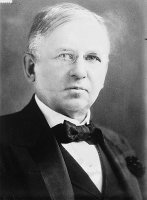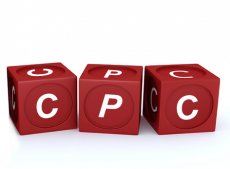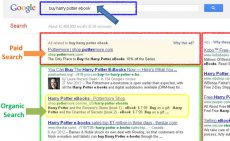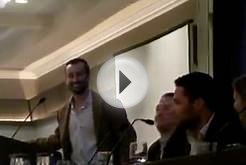 We now turn to online advertising. The two most common forms are paid search advertising and display advertising. We’ll look at their use on the web and, increasingly, in social media, and we’ll look at how advertising can fit into book or ebook campaigns.
We now turn to online advertising. The two most common forms are paid search advertising and display advertising. We’ll look at their use on the web and, increasingly, in social media, and we’ll look at how advertising can fit into book or ebook campaigns.
Half the money I spend on advertising is wasted; the trouble is I don’t know which half. — John Wanamaker
Nineteenth century marketing pioneer John Wanamaker made a fortune in retailing but he’ll be remembered for the quote to the right.
The good news is you now have a much better chance than Wanamaker did of spotting which half of your advertising is working because online advertising is highly measurable.
It’s also big business. In many markets, online advertising has overtaken traditional media such as magazines and radio in advertising market share.
Publishers have traditionally been small advertising spenders, relying on booksellers, publicity and word-of-mouth to drive sales. But as publishers and authors focus more of their promotional efforts on reaching out directly to their readers, and in many cases selling directly to their readers, direct advertising is likely to play a larger role.
Online advertising basics
There is a huge range of advertising available online. Most of it falls into two basic types.
Paid search advertising
This is the largest advertising category, dominated by Google. Advertisers pay to have their ads displayed to users as they type queries into search engines. The ads usually appear as links in the search engine results pages.
 Display advertising
Display advertising
This is the next most popular form of online advertising. Ad banners appear on websites in various sizes, positions and formats, including text, images, and rich media. They can be displayed to all visitors, or their display can be triggered by the visitor’s profile, location or interests to make them more relevant and effective.
The emerging power of social media advertising
While most online advertising has traditionally run on search engines and websites, social networks including Facebook, Twitter and LinkedIn, are emerging as powerful channels to run advertising.
Most of the ads they offer are types of display ads, but because they know a lot about their users’ demographics, interests and online activities, they are proving very effective at targeting ad messages and generating leads. This opens up effective new advertising possibilities for book marketers. in more detail a little later.
How online advertising is sold
Online advertising — also referred to as interactive advertising — is generally sold using one of three methods.
Cost per click (CPC) — also known as Pay per click (PPC)
In this form of advertising, the advertiser is charged each time a visitor clicks on an ad.
For this reason, it’s often called performance-based advertising since you only pay for results. This is the method used in paid search advertising.
Cost per thousand impressions (CPM)
This method is most often employed for display advertising. The advertiser is charged by the number of times an ad is displayed to visitors, referred to as impressions.
 Payment does not depend on the ad’s performance but there are ways to track its effectiveness.
Payment does not depend on the ad’s performance but there are ways to track its effectiveness.
Fixed cost
Advertisers pay a fixed amount for an ad to appear for a period of time, regardless of how many times it is viewed or clicked on.
While you can deal directly with websites, most advertising is sold through ad networks which run your ads across a range of websites, based on parameters you select.
Among the biggest ad networks are Google AdWords and Microsoft adCenter.
How paid search advertising works
Search engine advertising is part of a larger field called search engine marketing (SEM). We’ve looked at one part of this field, search engine optimization (SEO), in which marketers try to beat the search engine’s algorithms so that their listings appear high up on the first page of search results for their chosen keywords.
You can’t buy a higher ranking on these pages and this method is also referred to as organic search to distinguish it from paid search in which you can pay for your listing to appear when a visitor searches for a keyword.
So, here’s how paid search advertising works.
- You, the advertiser, choose keywords and phrases that will trigger your ad.
- You buy these ads in an online auction by bidding for the keywords on a cost-per-click basis. That is, you agree to pay only when your ad is clicked on, not based on how many times it is seen.
- When a search engine user types a query that includes your keywords, your ad pops up at the top or side of the results page, in a section labeled ‘ads’ or ‘sponsored listings’. If the user clicks your ad, you pay.
- You limit your spending by specifying a daily budget limit. Your bid price determines whether your ad appears, and in which position – higher bids run near the top.
VIDEO: What is AdWords? (3:53) — Google
VIDEO: Writing online ads that attract customers (3:52) — Google
Online display advertising
Display ads are the advertising banners that appear on many sites including news sites and blogs. They usually include images and, increasingly, rich media like video and animations.
Ad sizes and placement
Banner ads generally run across the top or down the sides of websites. In recent years, the industry has established a number of standard ad units — specific sizes and formats — to simplify the job of creating and running these ads. Most websites that run advertising conform to these industry sizes.
Ad networks
Most online display advertising is sold through ad networks which represent groups of websites to advertisers. It is particularly prevalent in the market for smaller advertisers and websites. The ad networks also take care of the distribution and tracking of ads.












 A newspaper is a scheduled publication containing news of current events, informative articles, diverse features, editorials, and advertising. It usually is printed on relatively inexpensive, low-grade paper such as newsprint. By 2007, there were 6580 daily...
A newspaper is a scheduled publication containing news of current events, informative articles, diverse features, editorials, and advertising. It usually is printed on relatively inexpensive, low-grade paper such as newsprint. By 2007, there were 6580 daily...